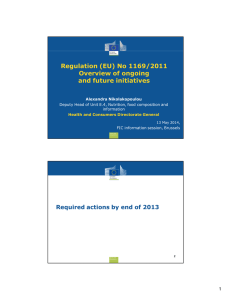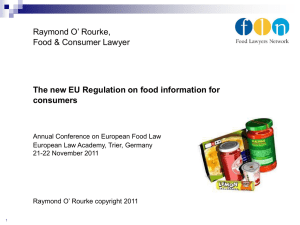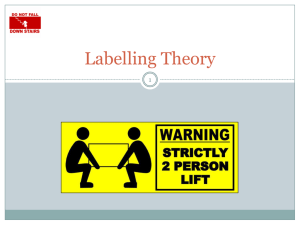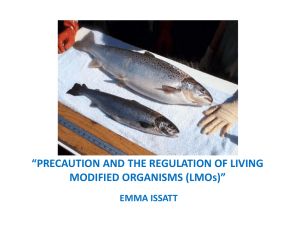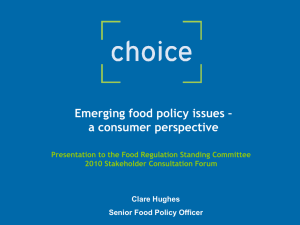Food Labelling Presentation
advertisement
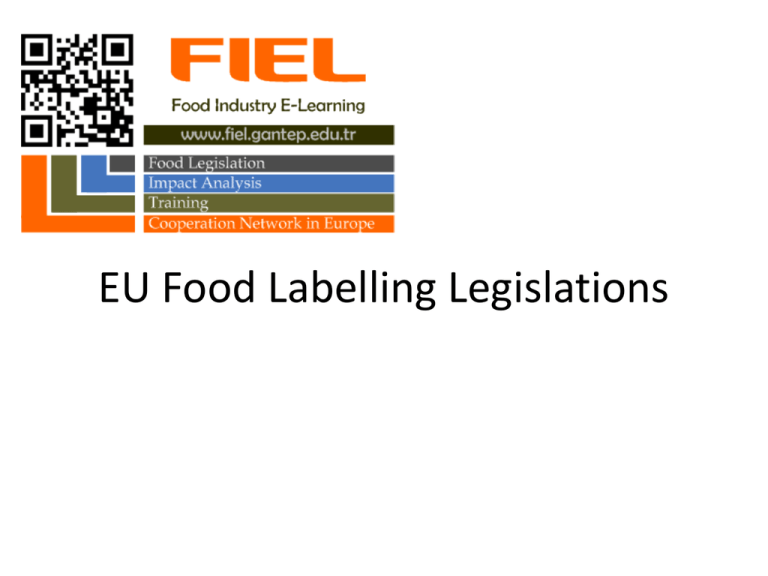
EU Food Labelling Legislations Food Labelling Legislation Documents and General Rules • Regulation (EU) No 1169/2011 of the European Parliament and of the Council of 25 October 2011 on the provision of food information to consumers • EU/1169/2011 regulates the obligation to provide food related information to consumers • All references to articles and annexes in the presentation are to the regulation EU/1169/2011, unless different document references are given. EU Food Labelling Legislaton Food Labelling Legislation Transitional Period • • • • EU/1169/2011 shall apply from 13th December 2014 EU/1169/2011 (mandatory nutrition declaration) shall apply from 13th December 2016 A voluntary nutrition declaration between 13.12.2014 and 13.12.2016 shall already comply with the regulation Foods placed on the market or labelled before the designated deadlines may be marketed until the stocks of the foods are sold out EU Food Labelling Legislaton Food Labelling Legislation Scope (Art. 1 (3)) This regulation shall apply to: • Food business operators at all stages of the food chain, if their activities concern the provision of food information to consumers. • • All sorts of food provided to the end consumer, including – foods delivered by mass caterers – foods intended to be delivered to mass caterers Catering services which provide food transport services , if the departure takes place on the territories of the Member States to which the Treaties apply (e. g. Airline Catering, Catering on cruising ships) EU Food Labelling Legislaton Food Labelling Legislation Definitions (Art. 2 (2)) a.) Food Information: Food information is all information provided to the end consumer by label other accompanying material any other means including modern technology tools or verbal communication (e.g. advertisment, internet, catalogues) d.) Mass Caterers: Any establishment such as restaurants, canteens , schools, hospitals, catering -enterprises, vehicles or fixed /mobile stall in which food is prepared for the consumption by the final consumers as part of a commercial activity. EU Food Labelling Legislaton Food Labelling Legislation Mandatory Information (Art. 4(1)) Information falling into one of the following categories are mandatory food information being in the scope of the food information law: a) Information on the identity, composition, properties or other characteristics of the food. b) Information concerning the consumers health and the safe use of a food. In particular, information on: – compositional attributes that could be harmful to the health of certain groups of consumers. – durability, safe use and storage – the health impact, especially on the risks and consequences concerning the consumption of harmful and hazardous food. c) Information on nutritional characteristics so that consumers with special dietary requirements can make informed choice EU Food Labelling Legislaton Food Labelling Legislation Basic Requirements (Art. 6) Any food intended for supply to the final consumer or mass caterers has to be accompanied by food information in accordance with this regulation. EU Food Labelling Legislaton Food Labelling Legislation Fair Information practice (Art. 7), part 1 1) Food information should not be misleading, particularly: • • • • Regarding to the characteristics of the food (nature, identity, properties, composition, quantity, durability, country of origin or place of provenance, method of manufacture or production) By attributing effects or properties to the food which it does not pocess By suggesting that the food possesses special characteristics although other similar products have those characteristics too, especially by highlighting the presence or absence of a ingredient and/or nutrient By suggesting the presence of a special food or ingredient due to the food appearance, description or pictorial representation even though in reality a component naturally present or an ingredient normally used was replaced by a different component or ingredient. EU Food Labelling Legislaton Food Labelling Legislation Fair Information Practice (Art. 7), part 2 (2) Food information have to be correct, clear and easy to understand by the consumer (3) Food information shall not attribute to any property of preventing, treating or curing a human disease nor refering to such properties. Exception: Union law applicable to natural mineral waters and foods for particular nutritional uses. (4) Paragraph 1,2 and 3 are also valid for: – advertising – the presentation of food (shape, appearance or packaging, used packing materials, way in which they are arranged and setting in which they are displaced) EU Food Labelling Legislaton Food Labelling Legislation Responsibilities (Art. 8) • • • • • • Responsible for the information is the operator under whose name or business name the food is marketed. For imported goods the importer. Food business operators, who do not influence food information, are not allowed to supply food which is not compliant with the food information law. It is not allowed to modify information, so that they become misleading for the final consumer Food business operators are obliged to check, if the requirements of the food information law are fulfilled. Ensure transmission of information for not pre-packed food. Transmission of information (prepackaging, label or commercial documents) on different levels of trade before distribution to final consumer and at the distribution to mass caterers EU Food Labelling Legislaton 1 Food Labelling Legislation List of Mandatory Particulars (Art. 9) 1. 2. Name of the food Name or business name and the address of the food business operator being responsible for placing on the market (ref. Art. 8) 3. List of ingredients 4. Date of minimum durability (“shelf live”)or the “use by” date 5. The quantity of certain ingredients or categories of ingredients 6. Alcoholic strength for beverages with more than 1,2% by volume of alcohol 7. Ingredients mentioned in Appendix II causing allergies or intolerances 8. The net quantity of the food 9. Storage conditions and/or conditions of use 10. Country of origin or place of provenance (Art. 26) 11. Nutrition declaration EU Food Labelling Legislaton Food Labelling Legislation Example: mandatory particulars [remark:an example (picture and text) demonstrating the mandatory particulars, taken from the national market is to be placed here] EU Food Labelling Legislaton Food Labelling Legislation Mandatory particulars for specific food (Art.10) Additional mandatory particulars for specific types or categories of food are listed in Appedix III. Examples: • “packaged under protective atmosphere” • “with sweetener(s)’, sugar(s) and sweetener(s)” • “ contains aspartame (a source of phenylalanine)” • “excessive consumption may produce laxative effects” • “contains liquorice – people suffering from hypertension should avoid excessive consumption” • “High caffeine content. Not recommended for children or pregnant or breast-feeding women” • “with added plant sterols” or “with added plant stanols” • “the date of freezing or the date of first freezing in cases where the product has been frozen more than once” EU Food Labelling Legislaton Food Labelling Legislation Placement of Information(Art 12;16) • • • • • • • Pre-packed food: directly on the package or a label attached thereto Non pre-packed food: Provisions of Art. 44 (national measures for non prepacked food) shall apply. Moreover allergen labelling is obliged. Information shall be easily visible, clearly legible, when appropriate indelible, not hidden, obscured or detracted by any other written or pictorial matter Font size (x-height) 1,2mm or 0,9mm if the largest surface is less than 80cm2 Name, net quantity and alcoholic strength of the food should appear in the same field of vision Information shall appear in a language easily to understand by the consumers Distance selling (e.g. Internet): mandatory food information except date of durability or “use by” shall be available before the purchase is concluded EU Food Labelling Legislaton Food Labelling Legislation Definitions: Distance communication, x-height Distance communication: Any means which, without the simultaneous physical presence of the supplier and the consumer, may be used for the conclusion of a contract between those parties. x-height: 6 = x-height EU Food Labelling Legislaton Food Labelling Legislation Omission of Certain Mandatory Particulars Article 16: • Glass bottles intended for reuse with an indelible imprint. Mandatory particulars: Name, allergen labelling, net quantity, date of durability and nutrition declaration • Packaging with an largest surface < 10cm². Mandatory particulars: Name, allergen labelling, net quantity, date of durability, list of ingredients has to appear in a different manner. • No mandatory particulars for food listed in Appendix V • Foods with > 1,2% by volume of alcohol: list of ingredients and nutrition declaration is not mandatory. Article 44: Foods offered without pre-packaging, pre-packed for direct sale or pre-packed due to the consumers request: Allergen labelling is mandatory, other particulars according national rules EU Food Labelling Legislaton Food Labelling Legislation Name of the Food (Art. 17) • • • • • The name of the food shall be it’s legal name or it’s customary name. If necessary for understanding, the name of the food shall be accompanied by other descriptive information. Name of the food can not be replaced by a fancy name, a brand name or a name protected as intellectual property. If the name of a food manufactured in one Member State, but offered in another Member State, is not clear enough for the consumer, there shall be additional descriptions to prevent confusions and to better distinguish the food from others. Appendix VI: specific provisions/particulars of the name of the food EU Food Labelling Legislaton Food Labelling Legislation Particulars Accompanying the Name of the Food Appendix VI: • Particulars on the physical condition or specific treatment of the food, e.g. powdered, refrozen, freeze-dried, quick-frozen and concentrated • • Meat products, meat preparations and fishery products: – „formed meat“ or „formed fish“ – Indication of the presence of added water (>5%) – Indication of the presence of added proteins and their origin A component or ingredient that consumers expect to be normally used or naturally present has been substituted with a different component or ingredient has to be mentioned: – In close proximity to the name of the food – Font size which has an x-height of at least 75 % of the x-height of the name of the product EU Food Labelling Legislaton Food Labelling Legislation List of Ingredients (Art. 18 +19) • • • • • • The list of ingredients shall be headed by a heading which consist of or includes the word “ingredients” It shall include all the ingredients of the food, in descending order of weight, as recorded at the time of their use in the manufacture. Ingredients shall be designed with their specific names according to Art. 17 Nano-material has to be indicated by the word “nano”. Special cases are laid down in Appendix VII No list of ingredients, some examples: – Beverages with > 1,2% by volume of alcohol – Fresh fruits, vegetables and potatoes (uncut and unpeeled) – carbonated water – foods consisting of a single ingredient, where the name of the food enables the nature of the ingredient to be clearly identified EU Food Labelling Legislaton Food Labelling Legislation List of Ingredients: Omissions Constituents that don’t have to be mentioned in the list of ingredients: • • • • • The constituents of an ingredient which have been temporarily separated and later reintroduced Food additives and enzymes – present by migration principle – used as processing aids Carriers and substances which are not food additives but are used in the same way, and which are used in the quantities strictly necessary Substances which are not food additives, but are used in the same way and are still present in the finished product Water – Used for the reconstitution of an ingredient used in concentrated or dehydrated form – in the case of a liquid medium which is not normally consumed. EU Food Labelling Legislaton Food Labelling Legislation List of Ingredients: Water • • • • Added water and volatile products shall be listed in order of the weight in the finished product – calculated as the difference to 100% – no indication if amount is < 5%. This does not apply to meat. Ingredients used in concentrated or dehydrated form may be listed in order of weight as recorded before their concentration or dehydration Water used for the reconstitution of an ingredient used in concentrated or dehydrated form does not have to be mentioned. Ingredients used in concentrated or dehydrated foods which are intended to be reconstituted by the addition of water may be listed in order of proportion in the reconstituted product. In this case the list of ingredients must be accompanied by an expression, such as ‘ingredients of the reconstituted product’. EU Food Labelling Legislaton Food Labelling Legislation List of Ingredients: Order of Listed Ingredients • • All ingredients in descending order of their weight. A compound ingredient may be included in the list of ingredients, under its own designation in terms of its overall weight, and followed by a list of its ingredients (Appendix VII, E) – The list of ingredients is not compulsory where the composition of the compound ingredient is defined in current Union provisions, and if the compound ingredient constitutes less than 2 % of the finished product – Omission is not valid for food additives and allergenic substances EU Food Labelling Legislaton Food Labelling Legislation List of Ingredients: Omissions to the Order • • • Ingredients constituting less than 2 % of the finished product can be listed in a different order after the other ingredients Mixtures of fruit, vegetables, spices or herbs can be grouped together in the list of ingredients under the designation ‘fruit’, ‘vegetables’ or ‘spices’, this has to be followed by – the phrase ‘in varying proportions’ – a list of the fruit, vegetables or spices present. A similar consideration applies for refined oils of vegetable origin – If relevant with addition of the expression ‘fully hydrogenated’ or ‘partly hydrogenated ‘ EU Food Labelling Legislaton Food Labelling Legislation List of Ingredients: Food Categories • • • Certain ingredients are designated by the name of a category (laid down in Appendix VII, B), if relevant followed by a list of varieties included e.g. Fat (animal, fully or partly hydrogenated), Oil (animal, fully or partly hydrogenated), starches, flour Food additives listed in Appendix VII, C must be designated by the name of category – followed by their specific name or E number – if an ingredient belongs to more than one of the categories, the category appropriate to the principal function in the case of the food in question shall be indicated. e.g. food additives categories: acid, acidity regulator, antioxidant, stabiliser Flavorings shall be designated by the term “flavoring” and followed by a description EU Food Labelling Legislaton Food Labelling Legislation • • • • • Labelling of Ingredients Causing Allergies or Intolerances (Art.: 21) Labelling concerns substances listed in Appendix II (remark: often adressed as “allergen labelling”) Indication in the list of ingredients with a clear reference to the name of the substance or product as listed in Annex II – the name of the substance shall be emphasized through the font, style or background colour – Omissions of Art. 20 or Annex VII, B do not apply for substances listed in Annex II If a list of ingredients is not necessary: term “contains” followed by the name of the substance or product as listed in Annex II In case of several ingredients of one food category, each has to be labelled No allergen labelling in the list of ingredients is necessary, if the name of the food clearly indicates, that a allergen is present EU Food Labelling Legislaton Food Labelling Legislation Products Causing Allergies or Intolerances Cereals containing gluten and products thereof Nuts and almonds Crustaceans and products thereof Celery and products thereof Eggs and products thereof Mustard and products thereof Fish and products thereof Sesame seeds and products thereof Peanuts and products thereof Sulphur dioxide and sulphites at concentrations of more than 10 mg/kg Soybeans and products thereof Lupine and products thereof Milk and products thereof Molluscs and products thereof EU Food Labelling Legislaton Food Labelling Legislation Example: „allergen labelling“ [remark:an example (picture and text) demonstrating allergen labelling, taken from the national market is to be placed here] EU Food Labelling Legislaton Food Labelling Legislation Quantitative Indication of Ingredients (Art. 22) Quantitative indication/declaration [QUID]of ingredients is mandatory for: • • • • ingredients appearing in the name of the food ingredients usually associated with that product name by the consumer Ingredients emphasized/accented on the label in words, pictures or graphics ingredients essential to characterize a food and to distinguish it from other products with which it might be confused, because of its name or appearance. EU Food Labelling Legislaton Food Labelling Legislation No QUID necessary (Appendix VII) • • • • • • • • When the drained net weight is given When quantities have to appear on the labelling due to Union provisions When an ingredient is used in small quantities for the purposes of flavoring When the quantity of an ingredient is not essential to characterize the food where specific Union provisions stipulate precisely the quantity of an ingredient For ingredients covered by the indication ‘with sweetener’ App. III For vitamin and mineral with additional nutrition declaration Mixtures with permitted declaration ‘in varying proportions’ EU Food Labelling Legislaton Food Labelling Legislation Conducting QUID (Appendix VII) • • • • • General requirement: indicate ingredient content as a percentage, at the time of its/their use – either in or close to the name of the food – or in the list of ingredients in connection with the ingredient for foods which loose/have lost moisture: – original quantity of the ingredient(s) is related to the finished product – if indicated amounts of ingredients exceed 100 %: the weight of the ingredient used to prepare 100 g of finished product is to be indicated for volatile ingredients the percentage in the finished product is indicated if concentrated ingredients are used: percentage of weight recorded before concentration is indicated for concentrated or dehydrated food: indicate proportion by refering to the weight in the reconstituted product EU Food Labelling Legislaton Food Labelling Legislation Example: QUID [remark:an example (picture and text) demonstrating QUID, taken from the national market is to be placed here] EU Food Labelling Legislaton Food Labelling Legislation Net Quantity (Art. 23, Appendix IX), part 1 • • • • Net quantity expressed in litres, centiliters, milliliters, kilograms or grams: use units of volume in the case of liquid products use units of mass in the case of other products Package (pre-packed item) containing several individual pre-packed units: indication of total net quantity of individual units and total number of individual units (latter not necessary if individual packages can be seen and counted from outside); net quantity on individual unit Package (pre-packed item) with several individual pre-packed units which are not regarded as units of sale indication of total net quantity and total number of individual packages Solid food in a liquid medium: indication of net quantity and drained net weight EU Food Labelling Legislaton Food Labelling Legislation Net Quantity (Art. 23, Appendix IX), part 2 • • Food that has been glazed: the declared net weight of the food shall be exclusive of the glaze. No mandatory indication of net quantity: for food with considerable losses in volume or mass, which is sold by number or weighed If the net quantity is less than 5 g or 5 ml (applies not to spices and herbs) for food normally sold by number, provided that the number of items can clearly be seen and easily counted from the outside or, is indicated on the label. EU Food Labelling Legislaton Food Labelling Legislation Date of Mininum Durability • • • • “Date of minimum durability”: the date until which the food retains its specific properties, when properly stored Indication according to Appendix X and Article 24 (2) preceded by the term : – “ best before…” when the date includes indication of a day – “best before end..” when the date does not include indication of a day – followed by indication of date or place where the date is given on the package Indicate date with day, month and year in a not coded form • Durability < 3 months: no indication of the year necessary • Durability > 3 months: no indication of the day necessary • Durability > 18 months: only indication of the year is necessary If necessary a description of storage conditions to provide durability has to be given preceding the indication of the date of durability EU Food Labelling Legislaton Food Labelling Legislation No Date of Minimum Durability (Appendix X) No date of minimum durability has to be indicated for: • • • • • • • Fresh fruits and vegetables incl. potatoes, all unpeeled and uncut (does not apply for sprouting seeds or legume sprouts) Wine, liqueur wines, sparkling wines, aromatized wines, and similar products obtained from fruit other than grapes, and beverages falling within CN code 2206 00 obtained from grapes or grape musts Beverages containing 10 % or more by volume of alcohol Bakers’ or pastry cooks’ consumed within 24 hours of their manufacture vinegar, salt , solid sugar Confectionery products consisting almost solely of flavored and/or coloured sugars Chewing gums and similar chewing products EU Food Labelling Legislaton Food Labelling Legislation „Use by“ Date (Art. 24) • • • The date of minimum durability shall be replaced by the ‘use by’ date for foods which – are highly perishable from a microbiological point of view – after a short period constitute an immediate danger to human health After the ‘use by’ date a food shall be deemed to be unsafe in accordance with Article 14 of directive EC/178/2002 Indication of ‘use by’ date according to Appendix X: – preceded by the term “use by..” followed by the date or a reference to where the date is given on the label – date shall consist of day, month and possibly year in a not-coded form – “use by” date on every individual portion EU Food Labelling Legislaton Food Labelling Legislation Conditions of Storage and Use Article 25: • • If food requires special storage conditions and/or conditions of use, those conditions shall be indicated To ensure appropriate storage or use of the food after opening the package, the storage conditions and/or time limit for consumption shall be indicated Article 27: • The instructions for use of a food have to be indicated in such a way that it can be used in an appropriate way EU Food Labelling Legislaton Food Labelling Legislation Country of Origin,Place of Provenance • • Indication is mandatory: – if an absence could mislead the consumer regarding the true country of origin or place of provenance, especially when the label of the food creates the impression, that the food has a different country of origin or place – for meat falling within the Combined Nomenclature (‘CN’) codes listed in Annex XI. Where the country of origin/place of provenance of a food is given and where it is not the same as that of its primary ingredient: – additional provision of country of origin / place of provenance of the primary ingredient is required – it has to be indicated that the primary ingredient comes from an other country of origin / place of provenance EU Food Labelling Legislaton
